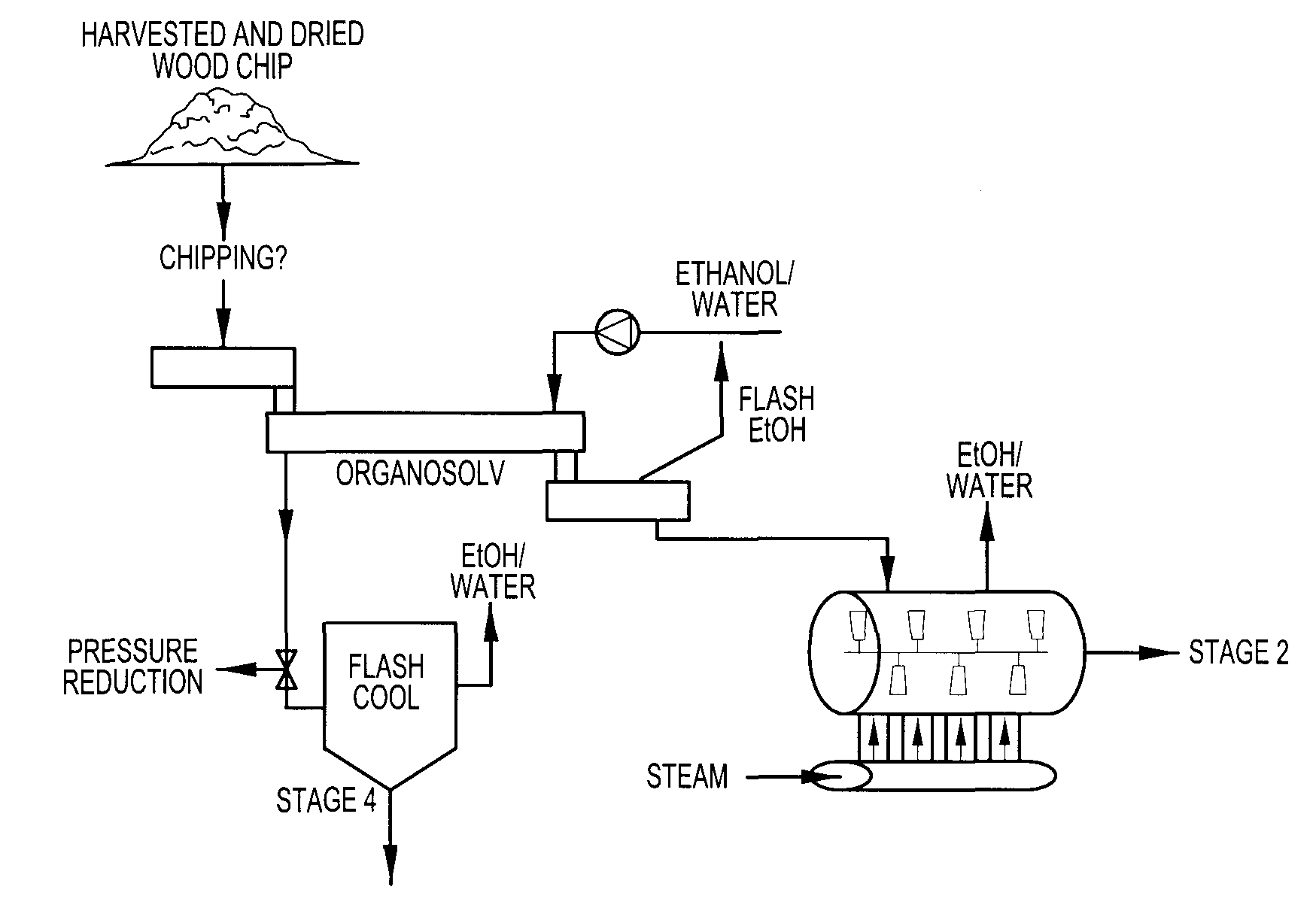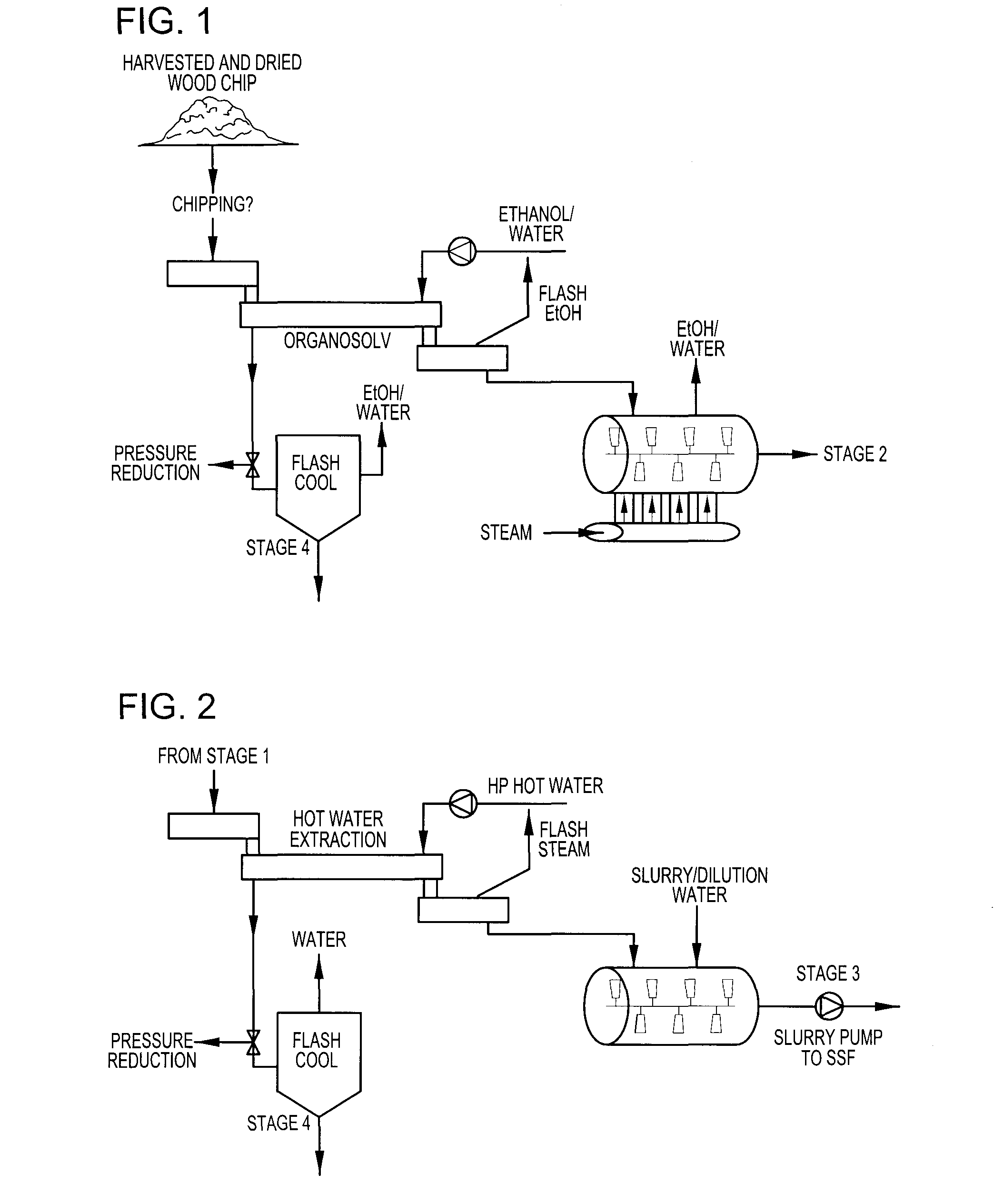Process for the production of biofuel from plant materials
a biofuel and plant material technology, applied in biofuels, lignin derivatives, organic chemistry, etc., can solve the problems of affecting the overall carbohydrate recovery, affecting the nature of the recovered lignin, and inhibiting further fermentation steps, etc., to achieve efficient and cost-effective use of plant biomass, rapid production of high volumes of biomass, and efficient fractionation of lignin
- Summary
- Abstract
- Description
- Claims
- Application Information
AI Technical Summary
Benefits of technology
Problems solved by technology
Method used
Image
Examples
example 1
Biorefining of Salix Biomass
Preparation and Composition Analysis of Untreated Salix Biomass
[0067]Stems of Salix viminalis or Salix schwerinii ‘Kinuyanagi’ were chipped with a garden mulcher. The wood chips were dried at 40° C. for 24 hours and sieved by hand between two wire meshes of British test sieve with apertures of 2.8 and 4 mm. The composition of the sieved and unsieved Salix chips was assessed, with the results being shown in Table 1. The mass composition was assessed using laboratory analytical procedures (LAPs) developed by the National Renewable Energy Laboratory (NREL, Golden, Colo.). Values are expressed as gram of component per 100 g of dry untreated chips. Extractives were isolated using a Soxhlet extractor, dried and weighed. Lignin concentrations were determined after chemical hydrolysis of the Salix chips (4 hours with 72% sulfuric acid at 102° C.). Acid soluble lignin was measured by densitometry at 320 nm and the concentration of the non-acid soluble lignin was m...
example 2
Biorefining of Wheat Straw
[0099]Table 5 shows the mass composition of untreated wheat straw and the composition of the hydrolysates and pulp produced during ethanol-water pre-treatment of the same wheat straw. The pre-treatment was applied as described above for the ethanol-water pre-treatment of the Salix chips in the 40 l batch digestor.
[0100]As seen in Table 5, only 27% of the initial dry matter was removed during sequential extraction with 70% ethanol and hot water. Therefore, less lignin was recovered in the ethanol solvent than when Salix chips were treated the same way. Also, a higher proportion of lignin was found in the wheat straw pulp. This may reflect the different type of lignin in wheat straw. As for the Salix pre-treatment, the pre-treatment of wheat straw with ethanol and water resulted in the recovery of all available glucose in the pulp.
TABLE 5Composition of solid andCompositionliquid stream after chip pre-Un-Treatedtreatment (% of total DW In)Product Recovery (% o...
example 3
Micropropagation of Salix Spp.
[0102]The technique of micropropagation was used to rapidly develop large numbers of clonal Salix spp. plantlets at low cost. Planting stakes of S. viminalis and S. schwerinii ‘Kinuyanagi’ were produced via micropropagation as follows.
[0103]To establish shoot cultures in vitro, stems from one-year-old Salix species grown in the field were collected in winter and cut into 25 to 35 cm long cuttings. The cuttings were washed in water, sterilized in 15% commercial bleach for 15 min and rinsed three times in water. The cuttings were then placed in a beaker containing water. Four to six weeks later, new shoots (5 to 10 cm long) were produced from the cuttings. The new shoots were collected and sterilized in 15% bleach after leaves were removed. The sterilized shoots were rinsed three times in sterile water in a sterile tissue culture hood. The shoots were then cut into 0.5 to 1 cm long micro-cuttings containing two nodes each. The micro-cuttings were placed i...
PUM
| Property | Measurement | Unit |
|---|---|---|
| temperature | aaaaa | aaaaa |
| temperature | aaaaa | aaaaa |
| temperature | aaaaa | aaaaa |
Abstract
Description
Claims
Application Information
 Login to View More
Login to View More - R&D
- Intellectual Property
- Life Sciences
- Materials
- Tech Scout
- Unparalleled Data Quality
- Higher Quality Content
- 60% Fewer Hallucinations
Browse by: Latest US Patents, China's latest patents, Technical Efficacy Thesaurus, Application Domain, Technology Topic, Popular Technical Reports.
© 2025 PatSnap. All rights reserved.Legal|Privacy policy|Modern Slavery Act Transparency Statement|Sitemap|About US| Contact US: help@patsnap.com



